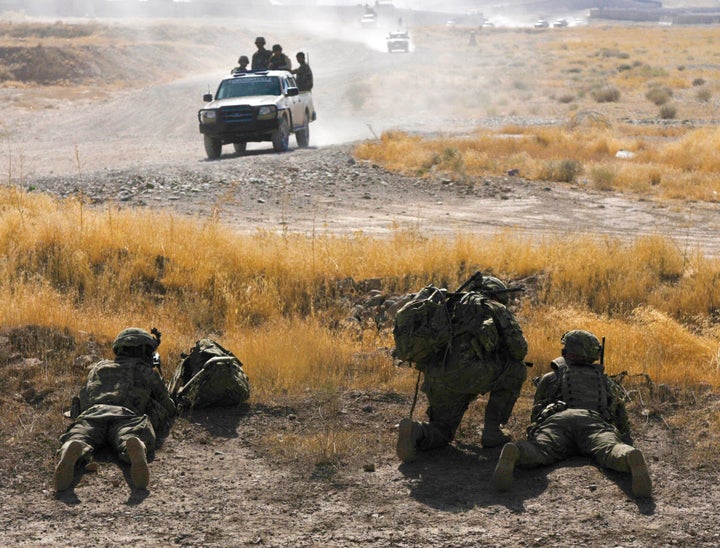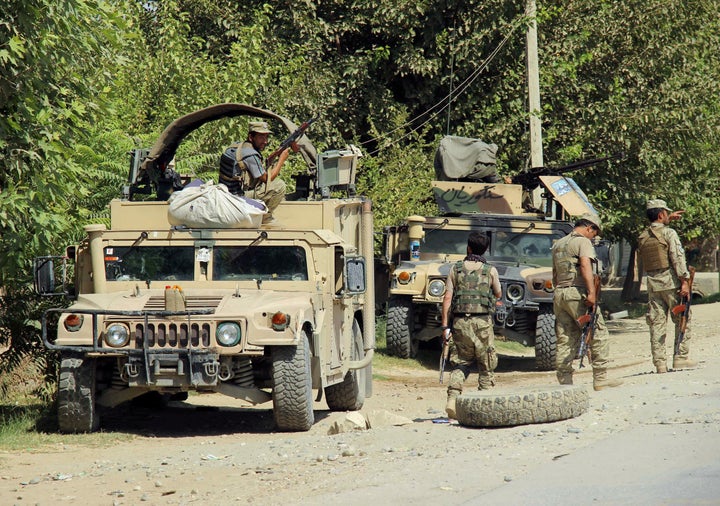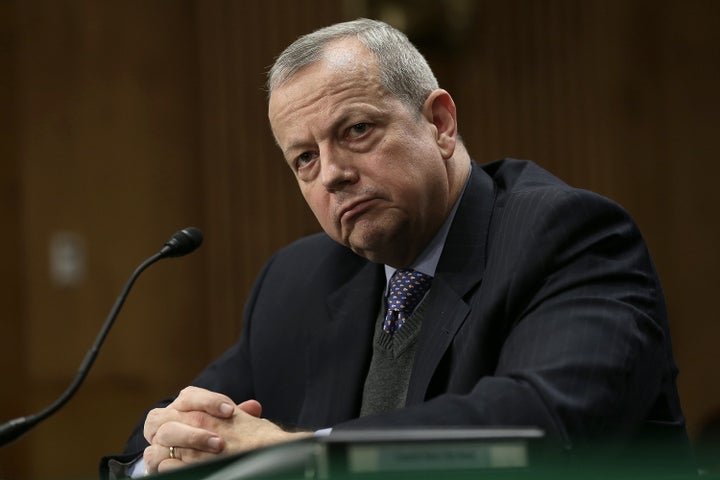

Afghanistan is failing.
Fifteen years after the United States first scattered the Taliban with high-altitude bombing, the battlefield gains achieved by tens of thousands of U.S. troops are in jeopardy from a resurgent Taliban.
The United States has spent $115 billion on this longest war in its history. The conflict has taken the lives of 1,865 Americans and wounded 20,224 (as of Nov. 16), many with life-shattering injuries. Yet the main goals set forth by Presidents George W. Bush and Barack Obama haven’t been achieved: Afghanistan does not have a stable, working democracy and terrorists still find a safe haven there.
Even stalwart defenders of the U.S. intervention, such as Vice President Joe Biden, now seem deeply concerned.
But few people in the U.S. are paying attention.
The 15th anniversary of the start of the war passed last month almost without notice. The stark choices facing President-elect Donald Trump ― more troops? more money? withdrawal? ― received no attention in the presidential campaign, an ill omen for the months ahead when careful and considered action will be needed.
And time is short.
Major cities across Afghanistan are under siege by the Taliban and other Islamic extremist militias, which are steadily taking more territory.
In their path, the U.S. has some 7,000 U.S. troops training and advising Afghan forces, and another 6,000 mostly special forces members engaged in counter-terrorism operations. Last week, two soldiers from the 1st Cavalry Division ― Sgt. John W. Perry, 30, of Stockton, California, and Pfc. Tyler Iubelt, 20, of Tamaroa, Illinois ― were killed by a suicide bomber at Bagram, the main U.S. military base in Afghanistan. Two American contractors, not identified by the Defense Department, died as well, and 17 people were wounded.
Also at risk are tens of thousands of Afghans, especially women and children, who have relied on the U.S. commitment to help safeguard what progress they have made in self-government, human rights and education. In growing violence, 30 people were killed Monday and more than 70 injured in a bomb blast at a Kabul mosque. The Islamic State claimed responsibility.
Little is known about Trump’s views on Afghanistan, although he has suggested that building schools there is a waste of money. In his most detailed comments, he declared in 2012 that the U.S. intervention is “a total and complete disaster.”
It likely will be months before the Trump White House can shift from such criticism toward a coherent strategy for Afghanistan.

The Afghan military and police have been unable to reverse the insurgents’ gains, despite the $68 billion spent by the U.S. trying to build up the country’s security forces. The Afghan army loses a third of its soldiers every year between battle casualties, desertions and those who decline to re-enlist. Officials reportedly pocket the pay of legions of non-existent “ghost soldiers.”
The Taliban “continue to expand their influence,” the Pentagon acknowledged this fall. U.S. Army Gen. John Nicholson, the senior commander in Afghanistan, told reporters in July that the overstretched Afghan army has basically conceded parts of the country to the Taliban.
The most recent data provided by the Pentagon to the U.S. Special Inspector General for Afghanistan Reconstruction show that among the country’s 407 districts, the number controlled by the government slipped from 267 in May to 258 in August. The Taliban controls only eight districts and influences another 25, according to the Pentagon data. But a new independent analysis found worse news: The Taliban actually controls or influences 97 districts, up from 70 a year ago.
It is from these districts that insurgents have been able to launch serious and continuing assaults on five provincial capitals: Kunduz in the north, Maimana in the northwest, Tarin Kowt in the southeast, Farah city in the west and Lashkar Gah in the south.
The northeast city of Gormach, a vital post on the strategic Ring Road that links a number of major cities, was overrun this fall. Kunduz, where U.S. and allied troops spent years training security forces and helping stabilize the local economy and government, has been overrun twice. This fall, hasty reinforcements of Afghan special forces in Kunduz and Lashkar Gah, aided by U.S. airstrikes and U.S. special forces, narrowly beat back determined Taliban attacks. Rebel forces remain on the outskirts of those cities and sporadic fighting continues.
And in the western city of Mazar e-Sharif, site of a major German and U.S. military base, the German consulate was hurriedly evacuated last week after Taliban fighters attacked with a massive truck bomb, killing four Afghans and wounding 128.
It’s pretty grim.Patricia Gossman, senior Afghanistan analyst for Human Rights Watch
Local corruption, ethnic squabbling and inept officials have eroded the population’s faith in their government and effectively provided the Taliban with safe bases from which to continue their attacks, according to an analysis by two U.S. Army officers who served in Kunduz.
The latest Taliban gains, even if temporary, have further shaken the people’s trust. Forty-two percent of Afghans say security is worse than it was under Taliban rule in the 1990s, according to the latest United Nations report. The number of refugees fleeing to Europe has increased 83 percent this year.
As the war grinds on, violence has intensified to horrifying levels and civilians are increasingly the victims. The new Afghan air force alone is responsible for a 72 percent increase in civilian casualties since 2015, the U.N. said. Suicide bomb blasts in July, also the work of Islamic State terrorists, killed 85 peaceful demonstrators and injured 413, in what the U.N. called the single most deadly incident in the country since 2001. And the number of dead and injured children has risen 15 percent this year, as the Taliban has attacked schools and health clinics.
“For God sake, don’t kill innocent Afghans,” an elderly widow from Kunduz, Bibi Gul, told the Pajhwok Afghan News. She had lost her 35-year-old son in the fighting. Stop the war, she begged, “or kill us all together to end our plight forever.”
People are scared, said Patricia Gossman, senior Afghanistan analyst for Human Rights Watch. “There are gains [by the Taliban], and now the attitude is, ‘We have to push them back regardless of the cost.’”
“It’s pretty grim,” she added. Gossman has been visiting and studying Afghanistan since the early 1990s.
Against these daunting problems, the national government’s awkward political power-sharing arrangement, brokered by the U.S. in 2014, has devolved into squabbling. In August, one chief executive declared the other “unfit” to lead the country. Systemic corruption continues to undermine attempts at reform, and opium production is skyrocketing.
“I regret there’s still real problems in Afghanistan,” Biden told NBC’s “Meet the Press” on Oct. 16. But with U.S. forces currently engaged in Iraq and Syria, he added, “there has to be a sense of humility about what is able to be done at the time.”

Yet some military and foreign policy experts argue that the U.S. intervention in Afghanistan, with its goal of a stable nation free of extremists, is not a lost cause yet. A “surge” of U.S. troop reinforcements would certainly help, some argue, and even at current levels, U.S. military advisers in Afghanistan could be given more leeway to engage directly in combat. For many who have served there, the bottom line is this: The United States cannot abandon those Afghans who were promised that the U.S. would stand by them.
Retired Marine Gen. John Allen, who commanded U.S. and NATO forces in Afghanistan from 2011 to 2013, is one who argues that Afghanistan is not “ready to go over the edge,” even though it might appear so from a distance. “I know from personal experience that Afghanistan always looks better close up,” he told The Huffington Post.
Allen cited the increase in life expectancy for Afghans, from 53 years in 1996 to 60.5 years today, as one hopeful sign that foreign investment in Afghanistan’s schools and health clinics is having an effect.
The retired general said the Obama administration’s decision to reduce U.S. forces in Afghanistan ― and to announce the timetable for the withdrawals ― damaged the American effort there. “That’s been hard to overcome,” he said. “Our words say we are committed; our actions do not.”
“But that’s water under the bridge,” Allen added.
Can Afghanistan’s slide toward failure be arrested?
John F. Sopko, the special inspector general for Afghanistan reconstruction, is in essence a congressionally mandated gumshoe looking over U.S. efforts. In an October report to lawmakers, he wrote that “systemic corruption, aggravated by floods of aid money, undermined the U.S. mission in Afghanistan from the outset and, unless effectively checked, will continue to undermine progress and could ultimately result in mission failure.”
“I’m cautiously optimistic,” he told HuffPost from Afghanistan, adding that he is “impressed at the hard work being done by Afghans in civil society, media and top leadership.”
“But much more remains to be done,” Sopko said.
The new administration should give the nation’s top Afghanistan experts 90 days, Allen suggested, to come up with a plan to bolster that nation’s security, economy and government performance. (He talked to The Huffington Post several days before the election and was not speaking specifically of Trump.)
Perhaps the one clearly wrong decision would be for Trump to put Afghanistan on the backburner. “Our hard-won successes are in the balance,” Sopko said.
And the Taliban advance.
Sign up for the HuffPost Must Reads newsletter. Each Sunday, we will bring you the best original reporting, longform writing and breaking news from The Huffington Post and around the web, plus behind-the-scenes looks at how it’s all made. Click here to sign up!